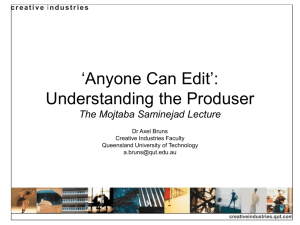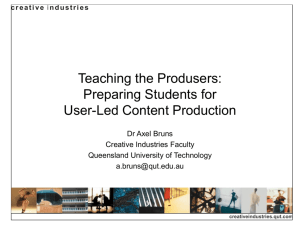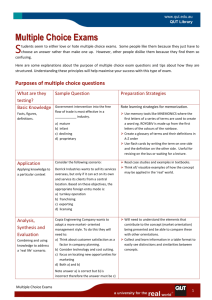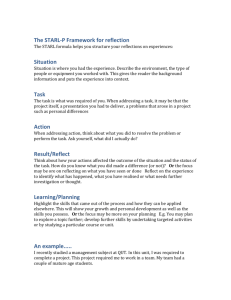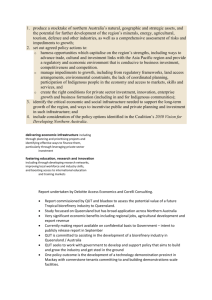Gatewatching
advertisement
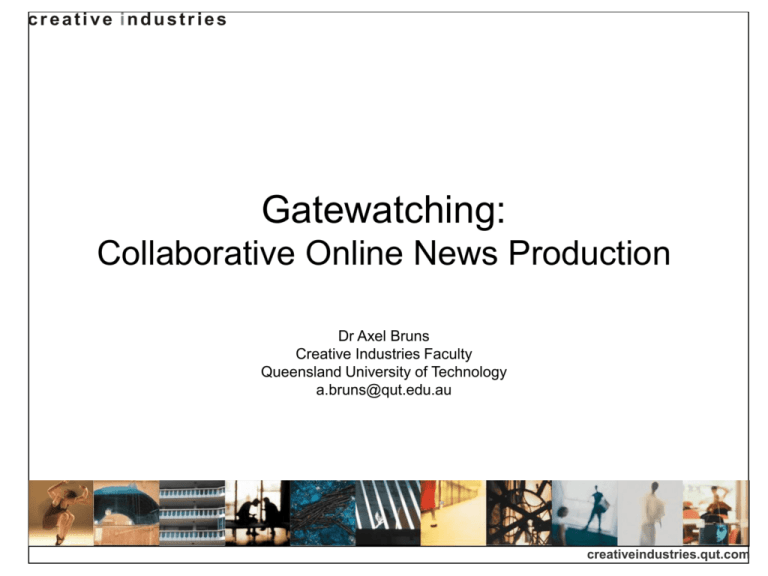
creative industries Gatewatching: Collaborative Online News Production Dr Axel Bruns Creative Industries Faculty Queensland University of Technology a.bruns@qut.edu.au creativeindustries.qut.com creative industries Industrial News Production ‒ Traditional news process: (from Bruns, Gatewatching: Collaborative Online News Production, 2005) creativeindustries.qut.com creative industries Against Gatekeeping ‒ Gatekeeping is outdated: • • • • • • media scarcity no longer exists too many gates to keep journalists’ judgment can (and does) fail ‘all the news that’s fit to print’ is patronising Fordist production model citizens want to be active and involved creativeindustries.qut.com creative industries Towards Gatewatching ‒ New form of collaborative news produsage: • observing what news passes through the gates of news and other organisations • highlighting those news items which are of relevance to the community • publicising rather than publishing the news: gatewatching rather than gatekeeping • adding commentary, analysis, and discussion to the news • post-Fordist production model, involving users as producers of news: they become produsers creativeindustries.qut.com creative industries Produsing the News ‒ Gatewatcher news process: (adapted from Bruns, Gatewatching: Collaborative Online News Production, 2005) ‒ Variations on the process are possible creativeindustries.qut.com creative industries Gatewatching and the News ‒ Rise of alternative online news: • in news-related blogs and collaborative online news sites • e.g. Indymedia, Slashdot, Kuro5hin, Plastic, OhmyNews • often in response to perceived shortcomings in the mainstream news media, as a corrective to the industrialised news process • creating a kind of open news • but not replacing the mainstream news media creativeindustries.qut.com creative industries A Second Tier of News ‒ Commentary and occasional first-hand reporting: • blogging as a ‘random acts of journalism’ (JD Lasica 2003) ‒ Realisation of model envisaged by Herbert Gans: • ‘a second tier of pre-existing and new national media, each reporting on news to specific, fairly homogeneous audiences’ • ‘devote themselves primarily to reanalysing and reinterpreting the news gathered by the central media, … adding their own commentary and backing these up with as much original reporting … as would be financially feasible’ • multiperspectival news – ‘a conception of alternative news’ (1980: 318) • ‘making a place in the news for presently unrepresented viewpoints … the bottoms-up corrective for the mostly top-down perspectives of the news media’ (2003: 103) creativeindustries.qut.com creative industries Towards Deliberative Journalism ‒ Multiperspectival news allows for deliberative journalism: • ‘It would underscore the variety of ways to frame an issue. It would assume that opinions – not to mention majorities and minorities – do not precede public deliberation, that thoughts and opinions do not precede their articulation in public, but that they start to emerge when the frames are publicly shared.’ (Heikkilä & Kunelius 2002) • ‘If contemporary American journalism is a lecture, what it is evolving into is something that incorporates a conversation and a seminar.’ (Dan Gillmor 2003) • dialogic deliberative news coverage is inevitably continuous and unfinished rather than ‘written up’ and complete creativeindustries.qut.com creative industries Open News and Open Source ‒ Open source approach to news: The basic idea behind open source is very simple: When programmers can read, redistribute, and modify the source code for a piece of software, the Software evolves. People improve it, people adapt it, people fix bugs. And this can happen at a speed that, if one is used to the slow pace of conventional software development, seems astonishing. We in the open source community have learned that this rapid evolutionary process produces better software than the traditional closed model, in which only a very few programmers can see the source and everybody else must blindly use an opaque block of bits. (Opensource.org) creativeindustries.qut.com creative industries Produsage ‒ Examples of produser-led content creation and collaboration: • open news • open source • open content repositories – e.g. Wikipedia, ccMixter, Flickr • collaborative knowledge communities – e.g. Google Earth • produser communities around commercial products – e.g. The Sims, Trainz creativeindustries.qut.com creative industries Political Implications ‒ Towards post-Fordist politics? • growing effect of produser news on political process ∘ towards more dialogue and deliberation, ∘ or more argument and conflict? • produsage as a sign of active, DIY citizenship • rear-guard battles by governments and news organisations against citizen journalists (e.g. Iran, China, Nepal, etc.) – but not only in authoritarian regimes • conflict between alternative and mainstream media coverage (e.g. Howard Dean campaign) • digital divide opening between traditional audiences and new produsercitizens? Is it possible to harness produsage to support a move of citizens from being a passive audience for to being active produsers of democracy? creativeindustries.qut.com creative industries Shameless Plug creativeindustries.qut.com
